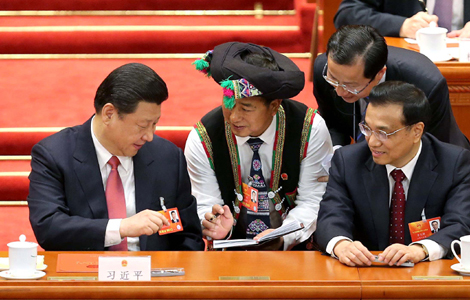What a big difference 20 years makes
Updated: 2013-03-12 06:41It is 20 years since I last worked at the annual two sessions as a photographer. I covered this national event for more than 10 consecutive years from the early 1980s.
So I felt lucky when I was given the task again, shortly before my retirement later this year.
However, as I grabbed my camera and rushed to the familiar venue, I found things had changed drastically.
While the venue, procedures and delegates' accommodation have largely remained unaltered over the years, changes were obvious even before I entered the meeting hall.
I saw delegates besieged by crowds of journalists, much larger than 20 years ago, on their way to and from the Great Hall of the People.
The number of journalists covering the two sessions has grown so dramatically that they seem to outnumber the delegates to the top legislature and top political advisory body. It was quite a shock when I later saw so many of them cramming themselves in for the opening ceremony.
And, of course, there are now many more cameras.
Foreign reporters are flooding in to cover the event, a contrast to two decades ago and a reflection of China's further opening-up and greater interest from the outside world.
Profound changes underlie the more obvious ones.
With a large number of new-media journalists joining the traditional newspapers and TV stations, journalists are more eager for diversified information.
Many delegates have become public faces thanks to the Internet, being bombarded by the media with endless questions and camera flashes.
A single incident or item of information can become news online in just minutes through new-media. I can imagine the pressure on delegates as they walk the short distance across Tian'anmen Square and are confronted by the media scrum.
But I have also noticed that most delegates and representatives have become more used to media bombardments than in the past.
Exchanges of information between delegates and the media have become an essential part of the meetings, and even senior officials can't ignore the media here.
As a veteran photographer, I knew my job wasn't going to be an easy one in this age of the Internet and with so many competitors.
Competition has intensified with the development of technology, and photojournalists have to work more efficiently than ever.
Twenty years ago, we had to return to the office to print our pictures in the darkroom before they were selected. It took a long time, but now we send them on-site via the Internet.
The Internet is also an effective tool to search for information. For example, I can learn which meetings key figures will attend next day.
When I was at the two sessions years ago, I remained mostly on the first floor of the main hall, close to the top leaders on stage, who were my main focus. This time, I had a different viewpoint - from the second floor along with hundreds of other cameramen.
But the change has worked for me. It seems I am finally getting the full picture of the two sessions after many years, by being farther from the center stage. Besides this, I don't have to use my elbows so hard to find space now, and shifting my viewpoint allows me to focus on areas I neglected in the past.
Instead of merely focusing my lens on the platform, I have found other areas of the meeting hall that merit coverage.
I zoom in on the vivid expressions of individual delegates, the brass band's performance and even photographers crowding together with their long, and short, lenses.
From my new vantage point I get a good view and catch those lighthearted moments when top leaders talk to each other on the stage. These pictures are exactly what we want nowadays.
However, greater flexibility for my work doesn't make it any easier. All I can do is to be creative and remain alert to capture the unusual as well as the ordinary.
Contact the writer at wang-wenlan@chinadaily.com.cn


